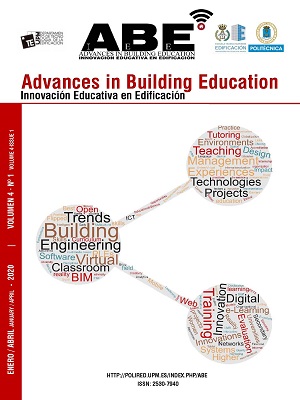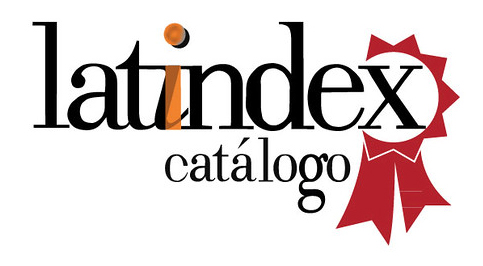Aula invertida con enfoque multidisciplinar = Flipped classroom with a multidisciplinary approach
DOI:
https://doi.org/10.20868/abe.2020.1.4415Keywords:
Absentismo, Abandono de estudiantes, Aula Invertida, Coordinación docente, Video educativo, Absenteeism, Dropout of students, Flipped classroom, Teaching coordination, Educational video,Abstract
En la Escuela Técnica Superior de Edificación de la Universidad Politécnica de Madrid, el profesorado ha detectado varios problemas que están relacionados con el aprendizaje del alumnado, entre otros nos encontramos con, el abandono de los estudios, el alto absentismo y la elevada compartimentación de los conocimientos. En muchas ocasiones los conocimientos adquiridos por los estudiantes en una asignatura concreta, no se aplican más allá de dicha asignatura o semestre. Con el fin de dar solución a los problemas anteriormente mencionados, varios docentes de distintas disciplinas han preparado cooperativamente varias asignaturas mediante el modelo de enseñanza de Aula Invertida. Tras aplicar la metodología de aula invertida propuesta en este trabajo y realizar encuestas al alumnado, se ha observado que en general los estudiantes están contentos con la técnica empleada. En concreto, del total de los encuestados se obtuvieron los siguientes porcentajes: el 3,5% muy en desacuerdo; el 8% en desacuerdo; el 21,5% no sabe; el 48% de acuerdo y el 19% muy de acuerdo. Por otro lado, a pesar de que el alumnado encuestado acepta la metodología empleada existe un 31% de estudiantes que no se muestra favorable a que sea ampliada a otras asignaturas. El trabajo realizado se enclava dentro del proyecto de innovación educativa “Conocimiento Transversal a través de Aula Invertida” realizado por varios integrantes del Grupo de Innovación Educativa UPM “Actitud Constructiva”.
Abstract
In the School of Building Engineering of the Universidad Politécnica de Madrid (UPM), lectures have identified several problems that are related to student learning. Among others we can highlight the abandonment of studies, the high absenteeism, and the high compartmentalization of knowledge. There are many situations in which the knowledge acquired by students in a specific subject is only applied to pass the subject and it is forgotten at the end of the semester. In order to solve the issues, a group of lectures from different disciplines have cooperatively prepared some subjects through the Flipped Classroom model. After applying the flipped classroom methodology proposed in this work and conducting student surveys, it has been observed that in general the students are happy with the method used. Specifically, the following percentages were obtained from the total of the respondents: 3.5% strongly disagree; 8% disagree; 21.5% do not know; 48% agree and 19% strongly agree. On the other hand, even though the surveyed students accept the methodology used, there are 31% of students who are not in favor of it being extended to other subjects. The work included in this paper were developed by several members of the “Actitud Constructiva” UPM Innovative Education Group. The work has been supported by the “Transversal Knowledge through flipped classroom” educational innovation.
Downloads
References
Tejada Fernández, J. y Ruiz Bueno, C. (2016) Evaluación de competencias profesionales en Educación Superior: Retos e implicaciones. [Evaluation of profesional competences in Higher Education: Challenges and implications]. Educación XX1, 19(1), 17-38, doi:10.5944/educXX1.12175 2016.
Rodamilans, M.; Gómez-Catalán, J.; Barenys, M.; Llobet, J. M.; Pubill, D.; and Quirante, J. (2018). Actividades de integración de conocimientos en el Grado de Farmacia. Aplicación en la asignatura de toxicología. Ars Pharmaceutica (Internet), 59(2), 99-107.
Rodamilans, M.; Cambras, T.; GómezCatalan, J.; Mitjans Arnal, M.; Llobet, J. M.; Moreno, J. J.; Teixidó, E.; Vinardell MartínezHidalgo, M. P.; Barenys, M. and Diez, A. (2010). La coordinación entre profesores de fisiología y toxicología: un caso práctico en la Facult
Berenguer-Albaladejo, C. (2016). Acerca de la utilidad del aula invertida o flipped classroom.
Griffiths, L.; Villarroel, R.; and Ibacache, D. (2016). Implementación del Modelo de Aula Invertida para el aprendizaje activo de la programación en ingeniería. In XXIX Congreso Chileno de Educación en Ingeniería SOCHEDI.
Alba, J.; Torregrosa, C.; Vidal, A.; and Del Rey, R. (2016). Flipped teching en Física del grado de Ingeniería de Sistemas de Telecomunicación, Sonido e Imagen. Primeros resultados. In Universitat Politècnica de València Congreso IN-RED.
Artal-Sevil, J.S.; Romero, E. and Artacho, J.M. (2017) “Quick surveys in classroom. Mobile phone, a powerful teaching tool”. INTED17 Proceedings of the 11th annual International Technology, Education and Development Conference, Valencia, IATED Academy, pp. 9282-9291.
Bain, K. (2006) “Lo que hacen los mejores profesores universitarios”, Valencia, Publicaciones de la Universidad de Valencia.
Fita, I.; Monserrat, J.F. and Moltó, G. (2017). “Aula Inversa: una oportunidad para el desarrollo de compentencias trasversales. Actas del Congreso In-Red 2016.
Gutiérrez, O. and Vicente, J. (2017) “Un año de FLIP: corrigiendo errores”. Actas del Congreso In-Red 2016.
Morera, I. (2017) “Hacia la clase inversa. Una experiencia de aprendizaje de la Química y de Desarrollo de Competencias en el primer curso de Grado de Ingenierías”. Actas del Congreso In-Red 2016.
Peña, B.; Zabalza, I.; Usón, S.; Llera, E. M.; Martínez, A. and Romeo, L. M. (2017). Experiencia piloto de aula invertida para mejorar el proceso de enseñanza-aprendizaje en la asignatura de Termodinámica Técnica. Red 2017. III Congreso Nacional de innovación educativa y de docencia en red. (pp. 583-206). Editorial Universitat Politècnica de València.
Downloads
Published
Issue
Section
License
Copyright (c) 2021 Autor / BY-NC-ND

This work is licensed under a Creative Commons Attribution-NonCommercial-NoDerivatives 4.0 International License.
ABE (Advances in Building Education / Innovación Educativa en Edificación) does not charge authors for processing or publishing an article and provides immediate Open Access to its content. All content is available free of charge to the user or his institution. Users are permitted to read, download, copy, distribute, print, search or link to the full text of articles, or use them for any other lawful purpose, without prior permission from the publisher or author. This is in accordance with the BOAI definition of open access.
- Authors retain the copyright and grant to the journal the right to a Creative Commons attribution / Non-Commercial / Non-Derivative 4.0 International (CC BY NC ND) License that allows others to share the work with an acknowledgement of authorship and non-commercial use.
- Authors may separately establish additional agreements for the non-exclusive distribution of the version of the work published in the journal (for example, placing it in an institutional repository or publishing it in a book).
Unless otherwise indicated, all contents of the electronic edition are distributed under a Creative Commons license.














